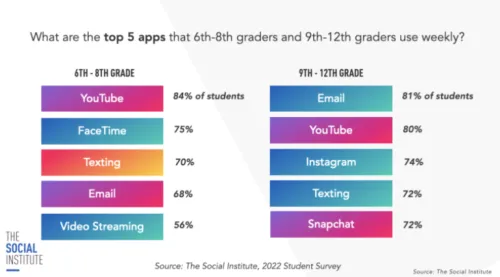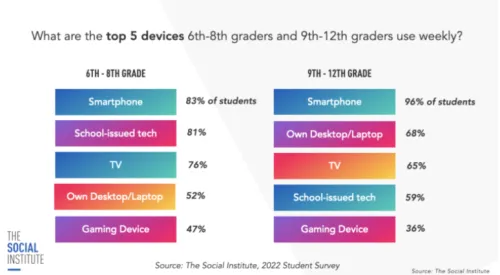Between phones, laptops, tablets, and more, it’s easy to get stuck in the endless cycle of staring at our screens – especially for students. Social media is simply how students are social. It’s a place for them to connect with others, look at entertainment, share stories, chat, and even learn about the world around them. Since so much of their life is online, it makes it hard to detach.
The Social Institute's founder, Laura Tierney, recently engaged in a thought-provoking conversation with child psychologist and school administrator, Dr. Jessica Anderson, exploring the profound impact of screen time on student success and a range of effective strategies to combat digital distractions within the educational sphere. Let’s dive into their insights:
Understanding the Influence of Screen Time on Student Success
In today's hyper-connected world, social media has become synonymous with socializing. Regardless of the grade level, students worldwide engage with and encounter social media on a daily basis, whether they are Snapchatting friends, commenting on Instagram posts, sharing TikToks, or gaming with friends on Fortnite.
The Social Institute's Student Kickoff Questionnaire, the largest of its kind in the nation, gathered insights from nearly 23,000 students across the country regarding their weekly device and app usage:


Students aren’t just using social media and tech outside of the classroom to socialize. Even before the COVID-19 pandemic, classrooms saw a surge in device usage. Schools, educators, and students have embraced technology as a means to socialize, stay up-to-date with current events, connect with local and global communities, and even learn. In fact, 80 percent of K-12 teachers who used social media in the classroom found that it had a positive impact.
However, this surge in tech adoption also introduced new challenges: digital distractions in the classroom and media multitasking. Digital distractions range from repeated app notifications to students texting during lessons, affecting the learning process and students' ability to concentrate. Media multitasking refers to performing multiple online tasks during a specified time, like studying online while chatting with friends or scrolling through social media.
These challenges that students now face are affecting the learning process and their ability to concentrate. In fact, research indicates that media multitasking can significantly reduce task efficiency.
Additionally, a 2020 study on media multitasking showed that “media multitasking during schoolwork interferes with students' attention and working memory, which produces shallower and spottier learning. Students understand less and have difficulty recalling and applying what they have learned in a new context.”
Understanding the Allure of Devices
It's important to recognize that students are not entirely to blame for their susceptibility to tech distractions. Given the frequency of smartphone usage, it comes as no surprise that apps and games are intentionally designed to trigger the release of dopamine. This chemical drives people to seek rewards.
Laura Tierney notes, "The numbers never lie. When we asked students what was the number one dopamine-releasing moment that is hardest for them to resist, they told us it was sending a message and checking what the person sends back.”
Drawing from her extensive experience with students, Dr. Anderson adds, "Students are highly invested in maintaining their Snapchat streaks, even sharing passwords to uphold these streaks, and staying perpetually engaged with social media updates."
Technology and social media are here to stay. Dr. Anderson emphasizes, "Technology is an integral part of our existence, whether we embrace it or not. It's a constant presence, and even if you wish to keep it out of the classroom, there are essential lessons we must give to students to help them navigate their digital social world."
Empowering Students to Manage Digital Distractions and Foster Effective Learning Environments
To address these challenges and foster an empowering learning environment, we recommend establishing clear technology standards in your schools, linking them to specific objectives, and providing the rationale behind these standards to build trust between you and your students.
5 Tips for Tech Leaders on Managing Digital Distractions in Your Educational Environment
1. Implement Tech Time and Tech Break
Equipping students with the skills to navigate technology responsibly is essential to their success in and out of the classroom. However, we know that media multitasking, especially in the classroom, impacts students’ ability to learn. To combat this, introduce designated times to use technology and designated tech breaks.
For example, you could choose one day a week to present your class with a question, let them use tech to solve it, and then take a “tech break” to hold a class discussion about the students' findings. Not only does this foster problem-solving skills, but improves students’ social skills and helps build strong classroom relationships.
Here are some more examples of good tech times and tech breaks:
Tech Time Examples:
- Use technology to support your lessons, such as interactive websites, videos, learning games like Kahoot, and digital lessons such as #WinAtSocial
- Allow students 5 minutes to be on their devices, talk about what they’re seeing online, and scroll through notifications. This will get the urge to check their devices out of their system and then they can turn it off, eliminating media multitasking.
- Digital field trips! There are so many different places your students can visit online, such as museums and zoos. By doing this, you’re proving to students how learning can be fun through technology.
Tech Break Examples:
- Allow your students a few minutes to walk outside when the weather permits. This helps students strike a balance with their devices while improving their health.
- Have your students put all devices away for a few minutes to have meaningful class discussions. You could even do student debates, which foster decision-making skills
- Take a few minutes to help students plan their day or their week without their devices. Print out a schedule maker or encourage planner use, and walk them through time blocking and the importance of scheduling breaks. Not only will this help them handle the pressure of school, but it will also instill the importance of designated work time without screens.
2. Foster High-Character Decision Making While Navigating Tech
As we know already, technology plays an important role in students’ lives. While there are numerous benefits to tech and social media, the devices and platforms don’t come without risks. Equipping students with the modern life skills to navigate gives students the knowledge, skills, and practices to engage safely and responsibly online and offline. This helps students avoid scams, privacy risks, cyberbullying, harmful content, and more. In addition, helping students build these skills empowers them to recognize the impact of the time they spend online, encouraging them to strike a balance with technology on a daily basis, and improving their focus when learning.
3. Encourage Technology While Setting Standards for Use
With TSI’s Classroom Tech Policy, educators can download an agreement to collaboratively set standards within the educational environment. Comprising ten customizable guidelines addressing social media, tech, and daily student experiences, schools can endorse and commit to these standards collectively.
Click here to access TSI’s Classroom Tech Policy.
4. Equip Educators with Resources for Balance
Educators have shared that having a well-defined plan for empowering students is the most effective approach to minimizing digital distractions in the classroom. Explore these concentration apps, endorsed by both students and educators, to assist students in maintaining focus during their academic pursuits:
- Apps to help you focus: The Flora app and Forest app both encourage students to stay focused on their tasks at hand through goal setting.
- Device Features: The Do Not Disturb Feature and Airplane Mode on devices block notifications while these features are turned on so that students are not distracted by the rings, pings, and dings of their favorite apps.
Social media and technology can be powerful tools in the classroom, contributing to enhanced learning environments and academic achievements. For further insights into best-in-class strategies that empower students to manage digital distractions and more, explore The Social Institute's School Playbook: Educators' Role in Empowering Students to Strike a Balance with Technology.
5. Utilize TSI's Screen Time Challenge
Maintaining a balanced online presence can be challenging. Dr. Anderson observes, "Students are often aware of technology's influence in their lives, but they don't always grasp the extent of their online engagement. Presenting it as a quantifiable figure can be quite eye-opening." The Screen Time Challenge helps students assess how their online activities align with their goals and interests.
Click here to access this challenge and use it in your classroom.
Empowering Your School Environment
Empower your own educators to navigate social media and tech in positive ways by encouraging them to incorporate technology and social media in their classrooms effectively and in positive ways.
Social media isn’t just for students; it’s a platform for everyone to connect, learn, share, and inspire. Apps like Instagram, TikTok, and Pinterest can help educators level up their classrooms and improve students’ learning experiences. So, how are you setting the example and showing students ways to use social media positively? After all, students can’t be what they can’t see.
Reach out to us today to learn how your school can empower both students and educators to effectively manage digital distractions in the classroom. Together, we can foster an environment where learning thrives and technology serves as a catalyst for growth.
